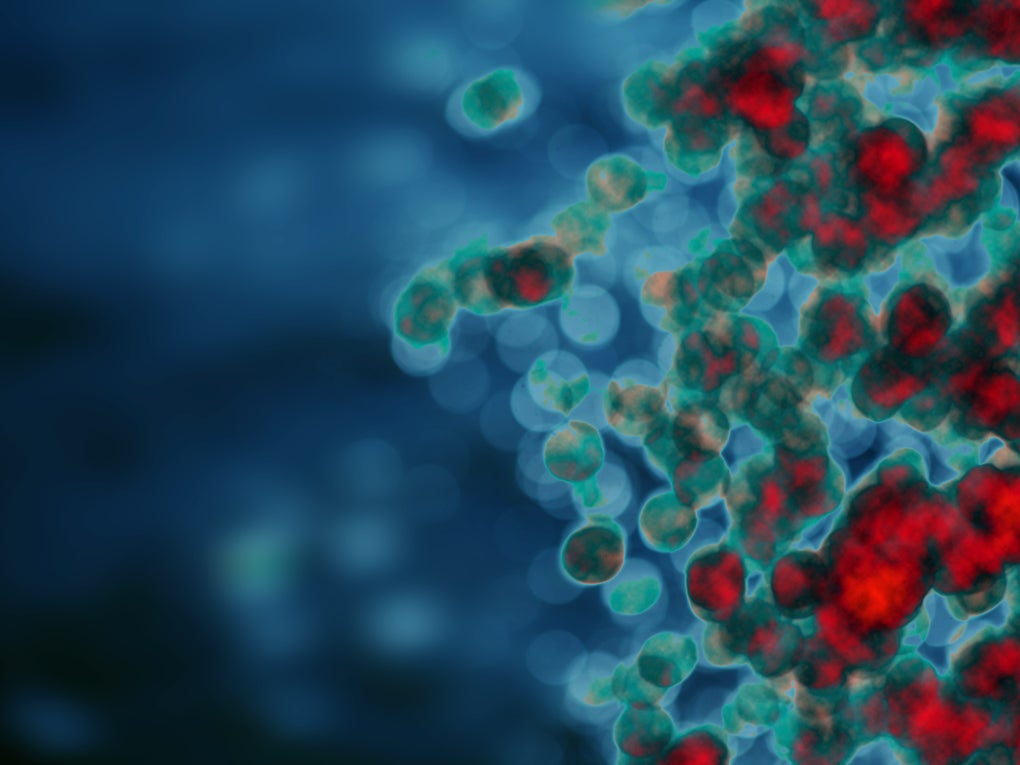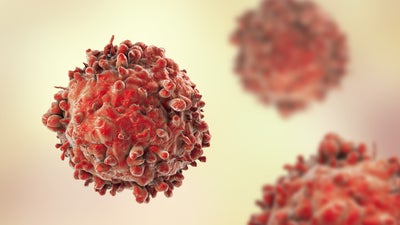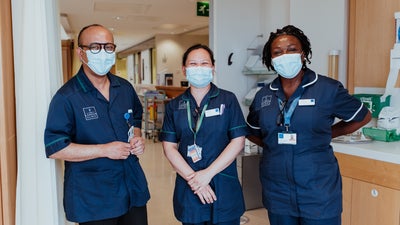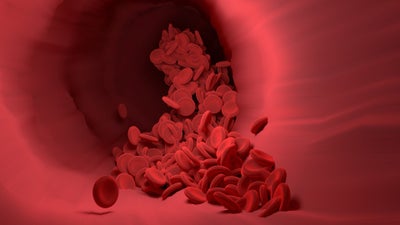
Types of blood disorder
Overview
Blood disorders include a range of conditions affecting the components and functions of blood. These disorders can significantly impact an individual's health by altering the production, quality and functioning of blood cells. Some of the most notable blood disorders include aplastic anaemia, sickle cell disease, thalassemia, autoimmune blood disorders, myelodysplastic syndrome (MDS) and myeloproliferative disorders.
Learn more: Blood and circulation
Aplastic anaemia
Aplastic anaemia is a serious but rare condition where the bone marrow doesn't make enough new blood cells. This affects red blood cells, white blood cells and platelets, which are all important for carrying oxygen, fighting infections and stopping bleeding.
When aplastic anaemia occurs, stem cells in the bone marrow get damaged. This damage can be caused by autoimmune diseases, where the immune system attacks its own cells, harmful chemicals like benzene, some medications, cancer treatments like radiation and chemotherapy, and viral infections like hepatitis. Sometimes, the exact cause remains unknown.
There are about 100 to 150 people diagnosed each year in the UK, making it a rare condition. Around half of all cases are diagnosed in people under 30, but there are two peaks in age, one in people between 10 and 25 and the other in the over-60s.
Symptoms
The symptoms of aplastic anaemia vary, based on which type of blood cell is low.
- Low red blood cells: causes tiredness, weakness, dizziness, and pale skin
- Low white blood cells: leads to frequent or long-lasting infections
- Low platelets: results in easy bruising, nosebleeds, and prolonged bleeding from cuts.
Treatment
The treatment for aplastic anaemia depends on its severity. Sometimes it is mild, and your doctor may simply monitor your health with regular blood tests.
It can improve on its own but may also worsen. You will need treatment to suppress your immune system, as this can help blood counts recover in up to three out of four cases. You will also receive blood transfusions to replenish your red cells and platelets and medications to prevent infections.
If you are young and fit enough, severe aplastic anaemia is treated with a stem cell transplant using donor cells: an allogeneic transplant. This is also the first option for inherited aplastic anaemia, as immune suppression is ineffective.
Learn more: Treatments for blood cancers and blood disorders
Outlook
Overall, around six out of 10 people with aplastic anaemia live for at least five years after diagnosis. Advances in treatment have improved survival rates significantly.
With moderate aplastic anaemia, it is nine out of 10. In many cases, the disease gets better and often requires less intensive treatment and monitoring.
The outlook can also be good for severe aplastic anaemia with treatment, but this depends on your age. This is at least partly because older patients often cannot have a stem cell transplant. But younger people also do very well on treatment to suppress the immune system, with nine out of 10 people aged under 60 living for at least five years.
These figures do not mean people only live for five years: many will have been cured. Patients who take part in clinical trials usually have their health monitored for five years after treatment, which is why this timeframe is often used.
Sickle cell disease
Sickle cell disease affects red blood cells. Instead of being round, they can become crescent-shaped, causing a sickle cell crisis. In a sickle cell crisis, the crescent-shaped red cells block small blood vessels and slow blood flow in larger ones, causing a great deal of pain and other symptoms. We do not fully understand what causes a crisis, but we know they can be brought on by infection, stress, cold, dehydration and extreme exercise.
You can only inherit sickle cell disease if both your parents carry the sickle cell gene. If you inherit the gene from one parent, that is called having sickle cell trait. You can then pass the gene on to your children, but you do not have the disease yourself.
There are around 17,500 people in the UK with sickle cell disease. It is often called sickle cell anaemia, or just ‘sickle cell’. This is a genetic condition present from birth. Anyone can have sickle cell disease, but it is most common in people from African and Caribbean backgrounds.
Symptoms
A sickle cell crisis is typically very painful, often causing pain in the bones, chest, or abdomen. Additional symptoms may include:
- swollen hands and feet
- swollen abdomen due to an enlarged spleen
- tiredness and lack of energy
- frequent infections with a high temperature.
Sickle cell is very variable in how it affects people; and the reasons for this variability are not well understood. Over time, sickle cell can cause complications and organ damage. People with sickle cell have a higher risk of:
- stroke
- blindness
- bone damage, and
- acute chest syndrome, causing breathlessness and chest pain.
Treatment
During a crisis, painkillers and oxygen are typically required. Your doctor will also address any known causes of the crisis, such as providing warmth or fluids. Various drugs can help prevent crises, and regular blood transfusions may be administered to boost normal hemoglobin levels.
The only cure for sickle cell disease is a stem cell transplant using blood cells from a donor (an allogeneic transplant). This option is usually considered for children with severe, hard-to-control sickle cell disease who have a relative with a closely matched bone marrow. For children without a close relative match, doctors are testing clinical trials using stem cells from unrelated donors, known as MUD (matched unrelated donor) transplants.
Outlook
The outlook for individuals with sickle cell disease has been steadily improving. Early screening of babies at birth allows for prompt treatment, and new treatments are better at controlling the disease and reducing complications.
Although statistically, people with sickle cell disease do not live as long as those without the disease, life expectancy is increasing as management of the condition improves. It is important to note that these statistics reflect past treatments, and children born today are likely to have even better outcomes.
Thalassaemia: beta-thalassaemia
Thalassaemia is a type of anaemia. The condition is due to a genetic mutation which affects the bone marrow's ability to produce sufficient haemoglobin, the protein responsible for carrying oxygen in the blood.
There are two main types of thalassaemia, alpha and beta. They are both genetic conditions that affect the production of healthy red blood cells. We have only included information on beta thalassaemia here, as stem cell transplants for alpha thalassaemia are still regarded as highly experimental.
You can only inherit beta-thalassaemia if both your parents carry a beta-thalassaemia gene. If you inherit the gene from one parent, you are a carrier. You can then pass the gene on to your children, but you do not have the disease yourself.
There are around 1,000 people in the UK with beta-thalassaemia. It is a genetic condition that you have from birth. Anyone can have it but it is most common in people from the Mediterranean, Middle East, India, Pakistan, Bangladesh and South East Asia.
Symptoms
Thalassemia symptoms vary depending on the severity of the condition. In the UK, babies are screened for thalassemia, enabling early treatment to prevent many symptoms. However, even with good management, individuals with thalassemia may be shorter than average and at risk of complications like diabetes and gland disorders due to iron overload.
Mild symptoms of beta-thalassemia minor (beta-thalassemia trait) typically cause mild anaemia, leading to fatigue, dizziness or weakness, frequent headaches and pale skin.
Beta-thalassemia major and beta-thalassemia intermedia can cause more severe symptoms including shortness of breath with exertion, heart palpitations, jaundice, dark or tea-coloured urine, slow growth or delayed development, swollen abdomen and frequent infections in infants.
Treatment
If you have beta-thalassaemia, you will need blood transfusions every few weeks throughout your life. A side effect of this is that too much iron builds up in your body. This can cause organ damage, so you need medication to remove it. This is called chelation therapy.
The spleen can become very enlarged with beta-thalassaemia. Your doctor may suggest a splenectomy operation to remove it. This will reduce the discomfort the enlarged spleen causes and can mean you do not need transfusions so often.
The only cure for beta-thalassaemia is a stem cell transplant using stem cells from a donor; an allogeneic transplant. The patient usually needs to have a relative whose bone marrow is a close match. For children who do not have a close relative who is a match, doctors are testing transplants in clinical trials using stem cells taken from unrelated donors. These are called MUD transplants, which stands for ‘matched unrelated donor’.
Outlook
People born with thalassaemia usually live a normal lifespan, as long as they have the right treatment and their conditions are managed properly.
Autoimmune disorders
Autoimmune disorders are not strictly blood disorders. They are a group of conditions caused by the immune system becoming overactive and attacking normal body tissues. A wide range of diseases fall under this category, including multiple sclerosis (MS), Crohn's disease, and rheumatoid arthritis.
Due to the diversity of these conditions, a variety of treatments are available, though not all are listed here. Stem cell transplants have been investigated as a treatment option under the following circumstances:
- the condition is severe
- the condition is not responding to treatment, or there is little or no treatment available
- there is a risk of serious organ damage if the condition continues untreated.
The theory is that a stem cell transplant ‘reboots’ the immune system, potentially curing the disease. It has been shown to be most helpful in cases of relapsing-remitting MS, Crohn's disease, and a disease called systemic sclerosis.
Patients suitable for a stem cell transplant nearly always receive their own stem cells back after chemotherapy to kill off their bone marrow cells; this is known as an autologous transplant.
Myelodysplastic syndrome (MDS) and Myeloproliferative disorders
These are two groups of conditions that were previously classified as blood disorders. As medical understanding of these conditions has advanced, their classification has evolved. They are now often described as cancers or pre-cancers.
Learn more: Myelodysplastic syndrome (MDS) and myeloproliferative disorders.
A blood cancer or a blood disorder diagnosis can feel overwhelming, but you're not alone. Partnering with DKMS can help you share your story and amplify our combined efforts to expand the stem cell registry, so do reach out to us. Together, we can create more hope and opportunities for people living with blood cancer.
References
Aplastic anemia: pathogenesis, clinical manifestations, and diagnosis. Epidemiology. UpToDate. Last reviewed September 2024.
Aplastic anaemia in adults. Summary. BMJ Best Practice. Last reviewed September 2024.
Aplastic anaemia in adults. History and exam: Common. BMJ Best Practice. Last reviewed September 2024.
Aplastic anaemia in adults. Treatment algorithm. BMJ Best Practice. Last reviewed September 2024.
Treatment of aplastic anemia in adults. Moderate AA. UpToDate. Last reviewed September 2024.
Guidelines for the diagnosis and management of adult aplastic anaemia. Summary of key recommendations: Key recommendations for supportive care. British Committee for Standards in Haematology (BCSH). Published October 2016.
About sickle cell. The Sickle Cell Society. Last reviewed September 2024.
Sickle cell disease. NHS. Last reviewed September 2024.
Sickle cell anaemia. Treatment algorithm. BMJ Best Practice. Last reviewed September 2024.
Overview of the management and prognosis of sickle cell disease. Survival and prognosis: overall survival. UpToDate. Last reviewed September 2024.
Beta thalassaemia and pregnancy. What causes beta thalassaemia? Royal College Obstetricians and Gynaecologists. Last reviewed September 2024.
Beta Thalassemia: Types, Symptoms & Treatment. Clevelandclinic.org. Last reviewed September 2024.
Thalassaemia. Presentation: signs. Patient. Last reviewed September 2024.
Thalassaemia. NHS. Last reviewed September 2024.
Thalassaemia. Management: thalassaemia major. Patient. Last reviewed September 2024.
Beta-thalassaemia. Management: Approach: Splenectomy. BMJ Best Practice. Last reviewed September 2024.
Management and prognosis of the thalassaemias. Stem cell transplant and gene therapy. UpToDate. Last reviewed September 2024.
Beta-thalassaemia. Prognosis. BMJ Best Practice. Last reviewed September 2024.
Myelodysplastic syndrome (myelodysplasia). NHS. Last reviewed September 2024.
Myelodysplastic/Myeloproliferative Neoplasms > Fact Sheets. Yale Medicine. Last reviewed September 2024.
Autoimmune Diseases: Types, Causes, Symptoms & Treatment. Clevelandclinic.org. Last reviewed September 2024.


